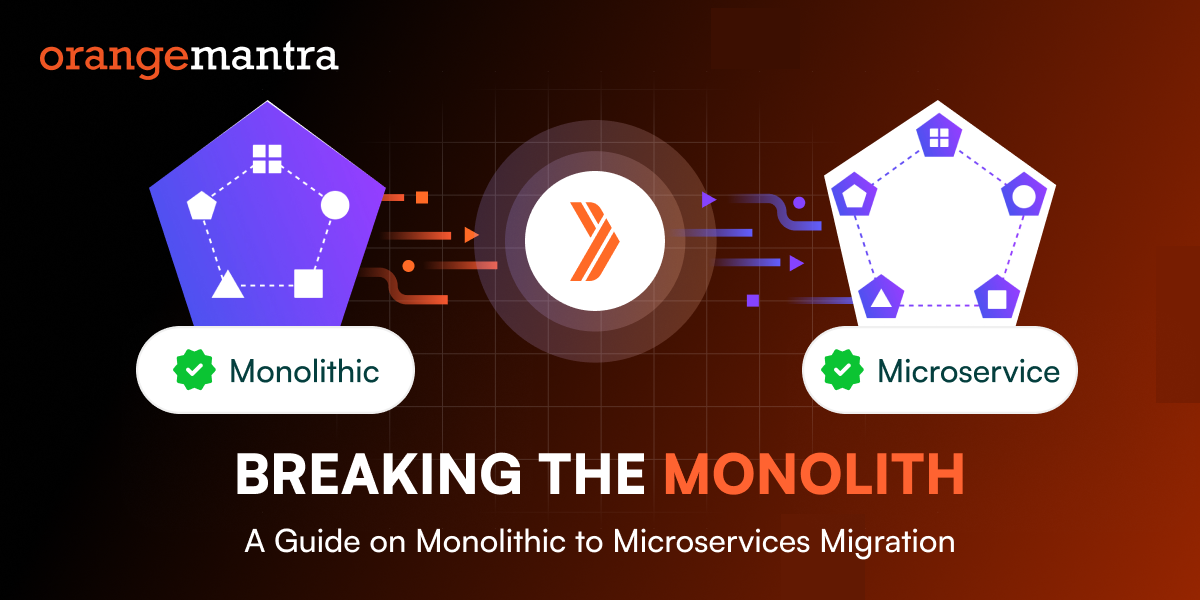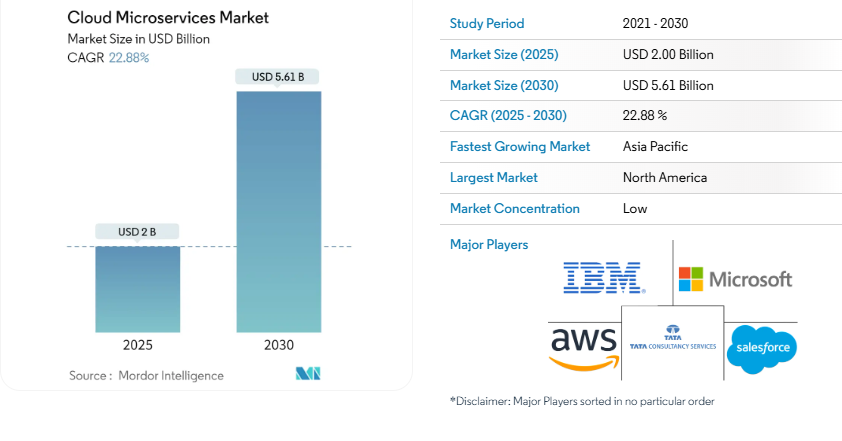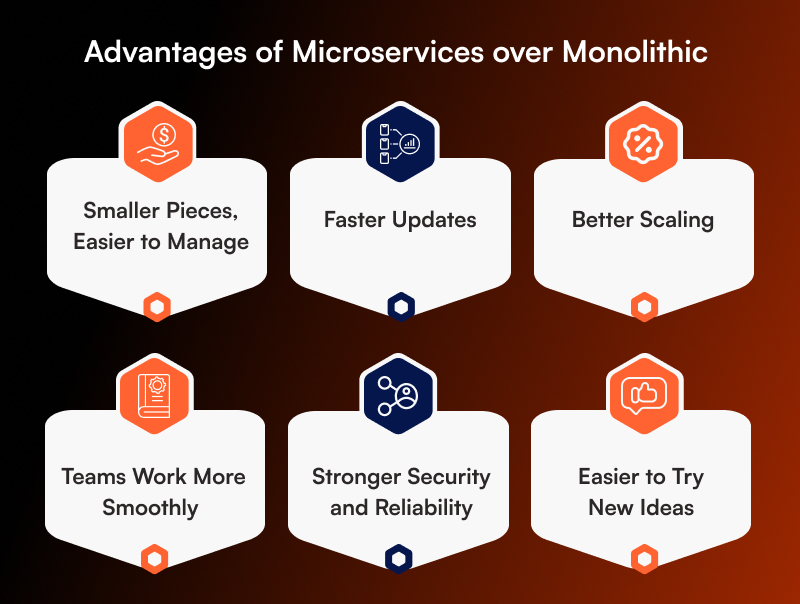
Here’s what you will learn:
Have you ever tried fixing a machine where all the parts are stuck together? That is how it feels to work with a monolithic program. Everything, from the code to the database, is combined into a single large block.
Even minor modifications might cause other things to break. This slows down the process, makes it difficult to update, and much more difficult to grow. As more users join your platform and their needs keep changing, this kind of setup becomes a problem.
In fact, a report from Mordor Intelligence says the cloud microservices market is expected to grow from $2 billion in 2025 to $5.61 billion by 2030. That shows how fast companies are moving away from these “all-in-one” systems.

This blog is for anyone tired of slow release cycles, code that’s hard to test, or apps that crash every time you tweak something. We’ll break down the process of monolith to microservices migration, so you can build smarter, faster, and more flexible systems.
Table of Contents
The Challenges of Monoliths
Initially, developing one large application may appear to be the simplest way to begin. Everything is in one place: design, features, and data. However, when your program expands, that “all-in-one” structure might become a major issue.
Here are some common issues that teams encounter with monolithic apps.
Hard to Update
If you wish to make a minor modification to one component of the software, you may need to rebuild the entire thing. It’s like having to rewire your entire house only to change a single lightbulb.
Slow to Release
Since all components are interconnected, testing takes longer, and minor issues might cause your entire release to be delayed. Teams end up spending more time verifying than developing new features.
One Problem Affects Everything
When one component of the code fails, it might bring down the entire app, even if the rest of it is running properly. This makes it difficult to keep things working well for your consumers.
Not Easy to Scale
Let’s imagine simply your website’s “checkout” feature requires extra power during purchases. In a monolith, you can’t merely raise that section. You must scale the entire app, which consumes time and money.
Tough for Teams to Work Together
With all of the code in one location, teams frequently walk on one another’s toes. If one team is working on the login and another on the homepage, their improvements may clash, resulting in delays or issues.
In simple terms, monolithic apps may function well at first but often fail as the firm expands. That’s why many businesses are turning to microservices to address these specific concerns.
Advantages of Microservices over Monolithic

Now that we’ve looked at the problems with monolithic systems, let’s talk about why many companies are considering monolithic to microservices migration.
Here are some of the top advantages of microservices over monolithic systems:
Smaller Pieces, Easier to Manage
In microservices, each part of the app is built as a small, separate service. For example, the login, search, and payment systems are all their own mini apps. If something goes wrong, you can fix that one piece without touching the rest.
Faster Updates
Since the services are separate, teams can update one without waiting on others. This helps businesses launch new features quickly — which is a big reason many start the monolithic to microservices migration process.
Better Scaling
With a monolithic app, you have to scale the whole system — even if only one part (like search or checkout) is getting lots of users. Microservices let you scale only what’s needed, saving money and resources.
Teams Work More Smoothly
Each team can own a different microservice. That means they can work at their own speed, use their favorite tools, and avoid stepping on each other’s work. This is one of the biggest advantages of microservices in large teams.
Stronger Security and Reliability
Because services are separate, a problem in one won’t crash the whole app. Also, you can give each service its own security rules, making it harder for hackers to break into everything at once.
Easier to Try New Ideas
With microservices, it’s safer to test new features or switch to better tech tools. If it doesn’t work, you can roll it back without affecting the whole system.
In short, monolithic to microservices migration architecture gives businesses more freedom, speed, and safety. It’s like replacing one big old machine with a team of small, smart robots — each doing their job well and working together.
12-Step Migration Framework
Monolithic to microservices migration isn’t something you can do overnight. It’s a step-by-step process that needs planning, patience, and teamwork. But the good news is — once you get it right, the benefits are totally worth it.
Here’s a simple 12-step path to help you through a smooth monolithic to microservices migration.
-
Understand Your Monolith
Start by taking a good look at your current application. Know how it works, which parts are connected, and where the pain points are. Understanding this helps you plan better when breaking things into microservices.
-
Set Clear Goals
What do you want to fix with microservices? Faster updates? Better performance? Lower costs? Make a list of your goals so your team knows what success looks like.
-
Identify the First Candidates
Not everything needs to be a microservice on day one. Pick a small, less risky part of the app; like user login or search as your first microservice. Choose parts that are easy to separate and don’t rely too much on others.
-
Design with Domains in Mind
Group services based on what they do for the business. For example, everything related to payments can go in one service. This is called domain-driven design, and it helps in organizing your microservices neatly.
-
Choose the Right Tools
Pick tools and languages that fit your team’s skills and your business needs. Many teams use Docker, Kubernetes, or REST APIs during monolithic to microservices migration. But keep it simple, don’t overcomplicate things in the beginning.
-
Set Up the Infrastructure
Before you move any code, build the base. You’ll need things like cloud servers, API gateways, monitoring tools, and CI/CD pipelines to make sure everything runs smoothly.
-
Write the First Microservice
Now it’s time to build. Start small, follow good coding rules, and test as you go. This is where you’ll really start to feel the advantages of microservices over monolithic systems — faster builds, less risk, and more freedom.
-
Deal with Data Carefully
In a monolithic setup, all services might share one big database. But in microservices, each service should own its own data. That way, one service won’t mess up another. Use sync methods or events to keep everything connected.
-
Connect the Services
Your microservices need to talk to each other. Use APIs or messaging systems so they can work together without being tightly linked. This keeps them flexible and makes it easier to update later.
-
Test Everything
Before going live, run all types of tests: unit tests, integration tests, and load tests. Make sure your new services don’t break anything. It’s better to catch problems early than deal with bugs later.
-
Launch Slowly
Don’t move the entire app at once. Roll out one service at a time, starting with low-risk areas. Watch how it behaves in real life, fix any issues, and then move on to the next.
-
Support Your Team
Monolithic and microservices architecture need different ways of working. Teach your team new skills, update workflows, and give them the freedom to own and manage their own services. A strong team is the key to long-term success.
This 12-step process isn’t just about technology — it’s also about people, planning, and progress. By following these steps, your business can go from old, slow systems to modern, flexible apps that grow with you. That’s the real power behind the advantages of microservices over monolithic systems.
Common Pitfalls to Avoid
Switching from a monolithic to microservices architecture is a smart move, but it’s not always easy. Many teams run into problems because they rush the process or don’t plan well. Knowing what not to do is just as important as knowing what to do.
Here are some common mistakes to avoid during a monolithic to microservices migration:
Trying to Do Everything at Once
Some teams want to break the whole monolith right away. That usually ends badly. It’s better to take small steps — move one part of the app at a time, test it, and learn as you go.
Skipping the Planning Phase
Jumping into coding without a clear plan is risky. You need to understand how your current monolithic app works, where the weak spots are, and how the pieces connect. A good plan helps avoid confusion and rework later.
Making Services Too Small
It’s tempting to split everything into tiny pieces. But if you go too far, it gets messy. You’ll end up with too many services to manage. Each microservice should handle a clear job — no more, no less.
Poor Communication Between Services
In monolithic and microservices migration systems, how services talk to each other matters a lot. If one service depends too much on another, you lose flexibility. Always aim for loose connections, like APIs or event messaging.
Ignoring Team Readiness
Switching from a monolithic to microservices architecture also changes how your team works. If your team isn’t trained or ready, they might struggle with the new setup. Make sure they have time to learn the tools and the new way of building software.
Not Setting Up Proper Monitoring
When you move to microservices, you have more moving parts. If you don’t track them properly, it’s hard to find bugs or performance issues. Tools that track logs, errors, and traffic can help you spot problems early.
Assuming It’s a One-Time Job
Some teams think the job is done once the services are built. But the real work begins after launch — keeping things fast, secure, and running well. That’s when you really start seeing the advantages of microservices over monolithic setups.
Quick Tip: Think of this migration as remodeling a house. You wouldn’t tear down all the walls on day one. You’d plan, start small, test the changes, and make sure everyone’s safe and comfortable before moving forward.
Conclusion
Making the move from a monolithic system to microservices is a big change, but it’s one that can bring long-term benefits. While monolithic and microservices architecture both have their place, it’s clear that today’s fast-moving businesses need something more flexible and easier to scale.
At OrangeMantra, we’ve helped many businesses in monolithic to microservices migration. If you’re thinking about making the switch or just want to know where to begin, we’re here to help.
FAQ
How to migrate from monolith to microservices?
To migrate from a monolith to microservices, start by understanding your current app — how it works, and which parts are most important. Then, break it down step by step. Pick one small feature, like login or checkout, and turn that into its own microservice. Test it, make sure it works well, and then move on to the next. Use tools like Docker and Kubernetes to help manage the new setup. Always plan carefully, take it slow, and monitor everything during the process.
What is a common challenge when transitioning from a monolithic to a microservices architecture?
One big challenge is keeping all the new microservices working well together. In a monolithic app, everything is in one place. With microservices, each part is separate, so they need to interact with each other in the right manner. If not handled properly, this can cause bugs, delays, or even crashes. It’s also tricky to manage data and keep things secure across many small services. That’s why planning and testing are so important.
Does migrating a monolithic system to microservices decrease the technical debt?
Yes, if done the right way. A monolith often has lots of old code that’s hard to fix or improve — this is called technical debt. By moving to microservices, you can rebuild parts of the app using better tools and cleaner code. This makes it easier to update and maintain over time. But be careful — if you rush or skip planning, you might just move the mess instead of cleaning it up.
What is the journey of monolith to Microservices?
The journey usually starts with a simple goal — like improving speed, scaling better, or making updates easier. First, you study your monolithic app and decide which parts to move. Then, one at a time, you turn each part into a microservice, test it, and connect it to the rest of the app. Along the way, you’ll set up new tools, change how your teams work, and slowly shift your whole system. It takes time, but step by step, your app becomes faster, stronger, and easier to grow.




